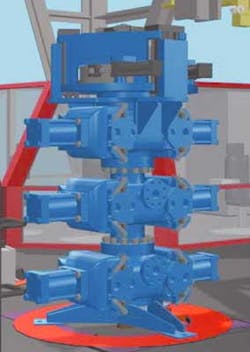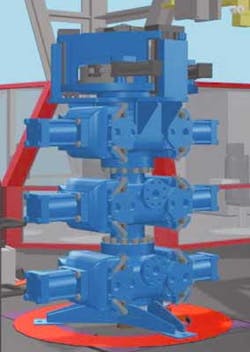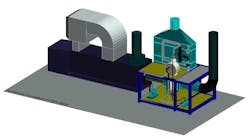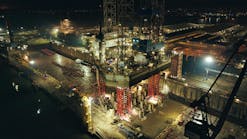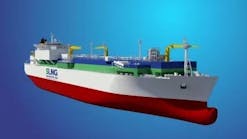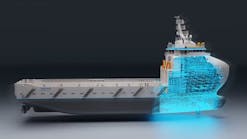DRILLING TECHNOLOGY: Continuous circulation coupler solves problems when fluid stops for joint change
Varco is calling this equipment the Continuous Circulation Sys-tem, or CCS. It will shortly be fabricating the Maris-designed prototype.
A simple system based on existing tech-nology allows drilling fluid to circulate continuously downhole during all drilling activities. By maintaining steady- state downhole pressures, flows, and temperatures, the system is claimed to greatly improve safety. The system was developed by UK-based Maris International Ltd, and is know as the Continuous Circulation Coupler.
Technical needs
According to Laurie Ayling, Managing Director of Maris, depending on oil prices, consultants such as Maris either have more work than they can handle, or none at all. Stepping back from its day-to-day operations, Maris looked at what new technologies the market needed and concluded that the greatest opportunity for reducing 'the cost of the bbl of oil' was in the drilling of the well itself. Analysis showed that the vast majority of drilling problems did not occur due to drilling itself, but were simply due to stopping the drilling in order to add another stand of drill pipe.
Ayling was convinced that if rigs could continue mud circulation while stands of drill pipe were being added, 80% of drilling problems would disappear. If continuous rotation could also be achieved, it would go a long way toward the ultimate goal of continuous drilling.
In 1995, Ayling started patenting a concept of a 'coupler' for continuous circulation. Unable to fund the full cost of development, some rights were sold to Coupler Developments Ltd. (CDL), and Maris secured the right to develop the coupler technology.
Even for simple wells, such a coupler would save time during the pipe make-up activities because there would be no need to circulate out the cuttings, raise the bit above bottom, or even weight the mud to hold the well in.
For more complex wells, there were a range of potential savings and increased capabilities. For example, under-balanced drilling (UBD) wells would not accumulate gas, extended-reach drilling (ERD) wells would achieve continuous cuttings mobility, and HP/HT (high pressure/ high temperature) wells could maintain a steady downhole pressure within a narrow pore pressure/fracturing pressure gap.
Developing technology
In December 1998, Ayling brought this continuous circulation concept before the Wells Group of the Oil & Gas Industry Task Force, set up by the UK Government's Department of Trade & Industry. Ayling said the concept was rated one of the top three most promising technologies for reducing cost.
To implement the recommendations of the task force, an organization called the Industry Technology Facilitator (ITF) was set up. ITF now has a membership of 14 oil companies. The ITF acts as a catalyst to facilitate joint industry projects (JIP).
Maris managed to get the Continuous Circulation Coupler project approved as ITF's very first JIP in April 2000, and funding for the project started in October 2000. By this time, Ayling said that he and private investors had spent over four years and $1 million in the development of the coupler. He said that ITF had been the valuable key to bringing the system forward and getting the operators involved.
Shell, BP, BG, Statoil, and Veba have now funded the outline design of the system, which was carried out by Varco under contract to Maris and completed in May. At this point Varco was selected as a natural choice to fabricate and market this product. "They know all about the components of the coupler," Ayling said, and could distribute, market, and support the coupler in the field.
Varco has now licensed the technology from CDL under a worldwide agreement that allows CDL to retain ownership of the technology and receive royalties and allows Maris to continue to develop the technology. Ayling said "The royalties from the coupler should generate several million dollars per year, and this will fund enough research and development to make a real difference to the industry."
Coupler concept
At any stage in drilling operations, there is an optimum downhole pressure. The mud weight and rate of circulation are adjusted to keep the pressure within the range required, but there is no way to keep this pressure near constant.
Simply put, if the pressure is too low, oil and gas may begin to flow into the wellbore and generate a 'kick.' If the pressure is too high, the formation may fracture and 'lost circulation' may occur. In some areas, these drilling margins are very narrow.
As it happens, a significant component of the downhole pressure is the dynamic pressure drop in the annulus, which is necessary to get the mud, cuttings, and debris to circulate back to the surface. Drillers refer to this dynamic pressure drop as the Effective Circulating Density (ECD), representing the mud density that would produce the same downhole pressure if the mud was not circulating. If it is possible to maintain a steady ECD, or steady downhole pressure, continuously, there would be many benefits.
Adding pipe
Using the conventional system, whenever a new stand of drill pipe has to be added to the drill string, drilling and mud circulation have to stop. The dynamic pressure drop to surface disappears, and the downhole pressure temporarily drops, often to a level below the static pressure. The cuttings and debris sink in the hole and settle on the bottom.
This static mud heats up. Then, when circulation begins again, there is a surge of pressure, which usually overshoots the steady circulating pressure. The drill bit, which has usually been raised off the bottom to lessen the chance of becoming stuck, has to drill through the settled cuttings and debris before recommencing the drilling of the formation.
The downhole pressure difference between the circulating and static conditions can be hundreds of psi, and the overshooting of the static pressure and the steady running pressures can also be hundreds of psi.
Basically, at the bottom end of the hole being drilled, several miles from the drilling rig, the effect of stopping circulation is at least highly inconvenient and can be disastrous.
Pressure control
With continuous circulation, the downhole pressure can be lowered to near the formation pore pressure. This is called 'near balanced drilling' and can increase the rate of penetration (ROP) of the drill bit dramatically. When the appropriate equipment is installed to handle oil or gas in the returning mud, the pressure can even be maintained at a level of under balance.
A major problem in under-balanced drilling is that the gas accumulates when drilling stops. This has to be circulated out of the hole before drilling operations can properly resume. With continuous circulation, the gas does not accumulate, and drilling can recommence as soon as the new stand of drill pipe is connected.
For lateral wells, and even more so for extended reach wells, the continuous movement of the returning mud and cuttings is vital to keeping the hole clear. Conventionally, in horizontal sections, when circulation and drillstring rotation stop, the cuttings only have to sink a couple of inches to settle - and perhaps, never move again. The is particularly the case since the renewed rotation of the drill string tends to mash the settled cuttings into the wellbore. The resulting reduction in effective wellbore diameter can cause the 'bottom hole assembly' to become stuck.
How it operates
The coupler operates like a control room airlock. The coupler is a pressure chamber that can seal around a drillpipe tool joint. The tool joint is disconnected under pressure inside the coupler. Mud is pumped into the lower half of the coupler and flows down the drillstring so that the top drive sub no longer needs to supply the circulating mud.
The top drive sub can be retracted into the upper half of the coupler, and a barrier can be closed between the two halves of the coupler. This done, the upper half can be de-pressured and drained, and the top drive can be extracted from the coupler to fetch another stand of drillpipe.
Meanwhile, the circulation of the drillstring continues with mud being supplied directly from the lower half of the coupler. The new stand is inserted into the upper half of the coupler, sealed, filled with mud, brought up to pressure, and the barrier is then removed so that the stand can be connected to the drillstring, without any interruption to the flow of drilling fluid. The components can be based on pipe rams for sealing against the drillpipe, a blind ram as the barrier and upside down slips for the snubber.
Closed loop system
The combination of a coupler and under-balanced drilling yields the 'closed loop system' that can properly control the downhole pressure. The mud input pressure can thus be adjusted or maintained at the optimum level through the entire drilling process. The ECD can be finely adjusted and maintained at any desired level continuously. This is a real improvement in safety, says Ayling.
For example, a kick is easier to detect. The pressure variations, which normally occur for up to half an hour or more after each connection due to variations in the 'cuttings in mud density,' the mud temperature and density itself, and accumulated gas, are now eliminated. There are no reverberations from the last circulation stoppage to mask the subtle first signs of a kick.
Also, kicks are far less likely to occur since the dramatic drops in bottomhole pressure are avoided.
A kick cannot occur while the mud is disconnected from the drillstring because it remains connected and flowing at all times. If a kick occurs, the pressure can be immediately adjusted and maintained, even while re-inserting stands of drillpipe to return the bit to bottom, when this is needed.
